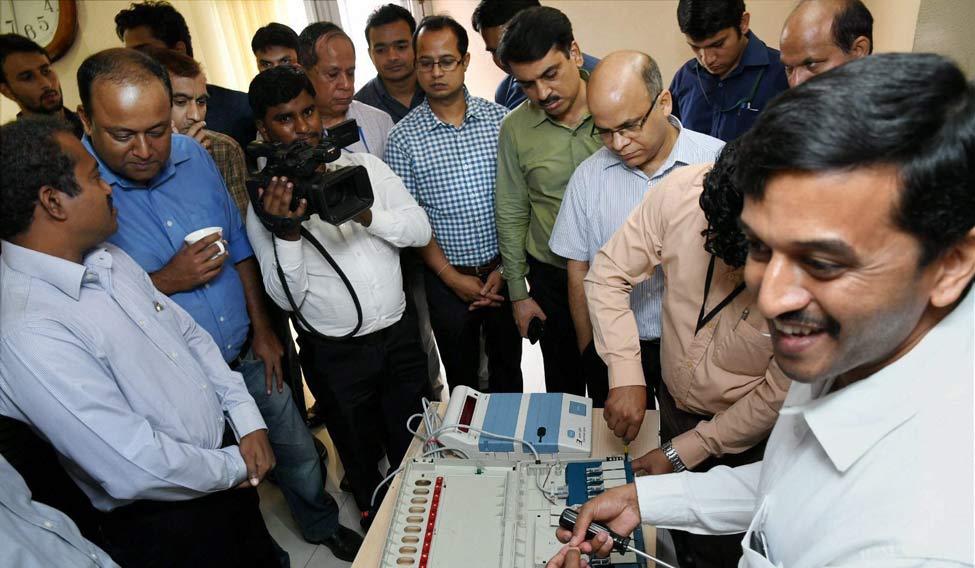It was not a hackathon, after all; it was only a challenge, insisted chief election commissioner Nasim Zaidi who spent a full day allaying fears of only two political parties—the NCP and the CPI (M) which finally took the bait and sent three IT experts each to Nirvachan Sadan (office of the Election Commission of India) on Saturday.
The Sadan had thrown its doors open to all registered political parties in the country to take up the challenge of trying to hack into their EVMs—a first of its kind exercise by the EC to restore the faith of the people in free and fair elections.
Many parties like the AAP and the BSP had been claiming that the Electronic Voting Machines were hostile to them. The ECI had invited 35 state recognised and seven national parties to participate in the challenge and try to tamper with the EVMs. There were barricades amidst high media deployment outside the EC office on Ashoka road in the capital. Strangely enough, the public could not witness the technical demonstration and deliberations that went on inside between the twin political parties and the EC officials. Neither the media entry was allowed, nor was a digital telecast available.
A string of political parties like the AAP, who had been making a flurry of allegations, raising the bar of suspicion on tamperability of EVMs, had already opted out. Even the NCP and the CPI(M), who had taken up the challenge and reached the venue, said they did not want to try to tamper with the EVM. In short, they did not take up the challenge.
For the CPI(M), it became an exercise in understanding the technical and administrative safeguards for EVMs while the NCP termed it an "academic exercise".
The NCP also faced some embarrassing moments when it said it did not know that the EVMs used during municipal polls in Maharashtra were not ECI machines but belonged to the state election commission. They asked the ECI to put its stamp on its machines so that the two machines can be easiy differentiated.
NCP's Rajya Sabha MP Vandana Chavan, however, was not satisfied with the way the challenge was being conducted. She told the EC that her party had put certain conditions like sharing the memory and battery numbers four days in advance.
The EC team informed her that those could not be shared as the 14 machines brought by the commission from states like Punjab, Uttarakhand and Uttar Pradesh for the challenge were "sealed" and kept in strong rooms . The numbers can only be retrieved at the time of testing in front of party representatives. But the NCP was unrelenting and submitted another letter to the commission with its suggestions. It refused to take up the challenge this time .
"I do not want to comment on what the political parties are saying. It is a purely technical subject as far as we are concerned. And we have showed to both the parties that the EVMs are tamper proof. We will definitely create more awareness amongst people. What we are also doing is introducing the Voter Verified Paper Audit Trail in coming months which will be used along with the EVMs. This will guarantee 100 per cent integrity of the systems we are using right now. There is no need to go back to ballot paper at all. We want to assure citizens that we will leave no stone unturned in ensuring the purity and integrity of our voting systems," Zaidi said.
Come 2019, when Prime Minister Narendra Modi completes five year in office and the stage is set for Lok Sabha polls in the country, the Indian voter is likely to witness a revamped system for casting his or her vote. Zaidi said the Election Commission of India was planning to introduce Voter Verified Paper Audit Trail (VVPAT) along with the EVMs by 2019. He said this system would provide real time feedback to voters when they are casting their vote .
For the time being, the EC had proved its point. The experts, who are working as technical heads in social media cells of the political parties, had ostensibly returned satisfied. What stuck out like a sore thumb at the end of the challenge was the lack of transparency both by the participants and the EC. The experts avoided the media waiting outside and slipped through another gate and the EC only threw open its gates for the media briefing after the challenge was over. By that time, experts had returned to their party offices and the machines were probably sent back to the strong rooms.





